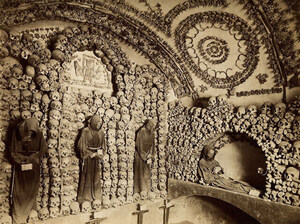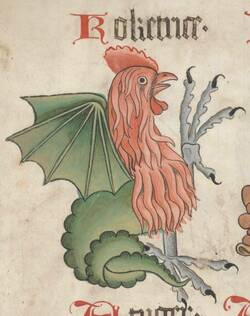From the Medieval Research Blog: "Gendering the Harpy: Mythology, Medievalism, and Macabre Femininity"

I have a fascination with the strange and obscure, and if I find oddities and curiosities during my travels that intersect with my medieval interests, even better. On a recent trip to Italy, I encountered a creature from both Greek mythology and medieval bestiaries at one of the most wonderfully macabre sites I’ve explored.
While on vacation in Rome this summer, I visited the Capuchin Crypt, an underground mausoleum containing an elaborate arrangement of human bones – lots and lots of bones. No one knows who designed the beautiful and haunting configurations comprised from the bones of approximately 3,700 bodies, presumably those belonging to Capuchin monks who sought refuge from religious persecution in France and perished while in Rome.
Unfortunately, photos are not allowed, and efforts to describe the intricacies and expanse of the design prove rather futile. Skulls and pelvic bones combine to create sculptures reminiscent of butterflies in the arches of doorways. Vertebra dot and line the ceilings of the chambers like so many fresco tiles. Massive piles of assorted bones have been shaped into seats for carefully posed skeletons. Reviewing his experience, the Marquis de Sade rated the exhibit five stars by modern standards.

But the crypt is a 17th-century construction. It’s the museum that contains the medieval bits, and that’s where I noticed an early print book, dated to the 15th or 16th century, that clearly depicted a cockatrice and that the museum had identified as a harpy. To be fair, the label included a question mark, indicating that the curator was unsure as to what kind of creature was on display.
Far less familiar than the harpy, the cockatrice is a legendary creature with a dragon’s body and a rooster’s head. The beast was believed to be hatched from a rooster’s egg incubated by either a serpent or a toad. Its first recorded mention in English appears in a Wycliffite bible dated 1382.
This is an excerpt from "Gendering the Harpy: Mythology, Medievalism, and Macabre Femininity" by Emily McLemore, Ph.D. Read the full story.